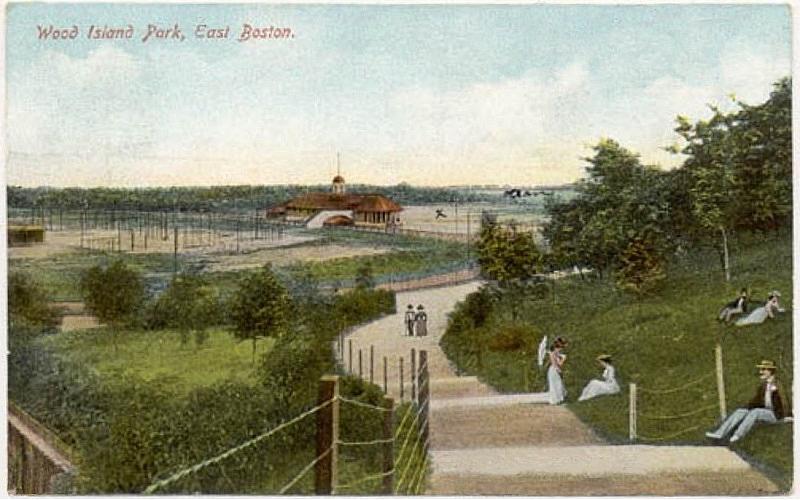East Boston lost its jewel of a park a long time ago, but the health effects linger for immigrant community

A postcard of Wood Island Park in East Boston.
(Image via Wikimedia Commons)
Wood Island Park was the crown jewel of East Boston. Tennis courts, ball fields, picnic areas and acres of public green space — all designed by America’s most famous landscape architect, Frederick Law Olmsted — were a refuge for residents of the neighborhood, which is separated from the rest of the city by Boston Harbor. The park opened in 1898, and for decades it represented an escape from concrete, asphalt and dense housing. “On hot days, people entered into the park in search of cool sea breezes beneath the huge 200-year-old elms, maples and oak trees,” journalist Dianne Dumanoski wrote in the magazine Land & People. “Children enjoyed rolling down the hills, and swimming in the beaches.”
Search for Wood Island Park on Wikipedia today, and you’ll find little to nothing. The park disappeared. It’s a ghost, digitally and physically. In the late 1960s, state and city officials razed Wood Island Park to expand Boston’s airport.
The public health effects of that decision — and more than half a century of a lack of access to public green space — may be seen among children in the neighborhood today.
East Boston has always been a thriving immigrant community. In the early 1900s, it was the site of the “East Boston Immigration Station” and provided a home for Irish, Jewish and Italian immigrants. Towards the end of the 20th century, the neighborhood became a destination for Latino immigrants, eventually becoming majority-Latino. According to the latest census data, East Boston is still a majority-minority neighborhood, with a larger share of Hispanic residents than any other part of the city.
The neighborhood is also the site of persistent health disparities. Obesity, specifically among children, is a problem. Neighborhood groups like the East Boston Neighborhood Health Center are working to curb the trend through initiatives encouraging outdoor activity among children. But decades of city planning — planning that appears to have sidelined Boston’s most vulnerable residents — cannot be undone easily.
When obesity trends are placed alongside East Boston’s history, a throughline emerges: A lack of access to public green space can be detrimental to childrens’ health.
This reporting project for the 2022 National Fellowship aims to trace a narrative from the destruction of Wood Island Park to the contemporary health disparities in East Boston, researching the decision-making behind the razing of the park and investigating the links between public policy and real-time disparities.
This project does not intend to put forth a straightforward narrative of cause-and-effect, but it will use the story of Wood Island Park as a lens for delving into the reality of health disparities. Obesity rates in East Boston are significantly higher than many other parts of the city. According to the most recent community health needs assessment report conducted by The Massachusetts General Hospital, 63% of adults in Eastie, as its known, have obesity. That figure highlights a troubling national trend: Latino people have the second-highest rates of obesity in the United States, behind only Black Americans, and surpass the general population in being overweight by 10%.
Among children, that statistic is more staggering: Latinos have the highest rates of obesity of any group, according to a recent report from the Trust for America’s Health and the Robert Wood Johnson Foundation. Recent studies, including research published in the International Journal of Obesity, have also demonstrated the effects that a lack of access to green space can have on health outcomes in a community, including obesity rates.
The goal of this project is two-fold: Through reporting that incorporates conversations with medical experts, advocates, public land enthusiasts and East Boston residents, it will not only investigate and highlight the potential policy roots of health disparities; it will also highlight the way a community can fight those disparities.
Childhood obesity is among the greatest health challenges facing the U.S. For Black and brown communities, the challenge is even more pertinent. Decisions like the destruction of Wood Island Park are often treated as happenstance — forgotten pieces of history that just are today. But that may not be the case — they may be concrete policy decisions with lingering health effects. This project aims to reckon with how these decisions continue to hurt the country’s most vulnerable communities.
